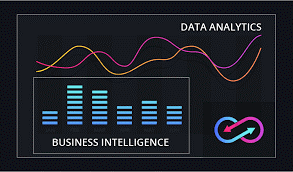
Key Differences between BI and Data Analytics

What is Business Intelligence (BI)?
BI refers to organizations' strategies, technologies, and processes to convert raw data into actionable insights. The outcome of BI is the generation of business insights that facilitate better decision-making. BI utilizes various business intelligence tools, such as Microsoft Power BI and Tableau, real-time monitoring dashboards, text mining, etc. Additionally, data analytics plays a key role in BI.
By leveraging BI, stakeholders gain visibility into the performance of their past, present, and future business operations, enabling them to identify improvement areas. Therefore, the primary focus of BI is to maximize profit by improving overall business operations.
What is Data Analytics?
Data analytics
refers to the processes and techniques used to analyze data and discover meaningful patterns, correlations, and insights. Examples include data collection, transformation, visualization, and modeling.
Data Analytics aims to uncover hidden patterns, generate predictions, and make data-driven recommendations to support decision-making processes
Key Differences between BI and Data Analytics
Primary purpose of BI and Data Analytics
- The primary purpose of BI is to improve organizations' overall profits by providing an effective decision-making process and strategic planning. For example, a supermarket chain may use BI to increase its sales at different seasons. It provides historical, current, and predictive insights to drive business performance, data management, and optimize operations.
- Data analytics focuses on transforming raw data to reveal patterns, correlations, and trends to generate insights for informed decision-making. This actionable information can be used for many purposes, and BI is one application that involves data analytics. Therefore, it is more exploratory in nature and focuses on extracting actionable information to solve specific business problems and optimize outcomes.
Data Types
- BI uses structured business data from various sources within an organization. Examples include data in data warehouses, relational databases, CRM systems, etc. BI uses these structured data to produce visualizations, dashboards, and reports which help businesses to see a holistic view of the business's performance and key metrics.
- Data Analytics uses structured, semi-structured, and unstructured data from various sources. Examples include data from sensors, social media, relational databases, spreadsheets, etc. It typically starts with unstructured data and applies data transformation techniques before preserving it for subsequent analysis.
Nature of data
- BI typically uses past data to provide past business performance and trends. This allows organizations to see what has already happened in the past and how the future strategy needs to be defined.
- Data Analytics also involves using historical data to discover past patterns. In addition, it uses real-time or near-real-time data for predictive analytics.
User Focus
- BI primarily aims at non-technical business users like chief executives, managers, and other leadership teams. These non-technical users can easily get a high-level view of their business performance using graphs, charts, and other visualization methods.
- Data Analytics caters to a diverse range of users, both technical and non-technical. This includes data scientists, researchers, programmers, and statisticians. Consequently, Data Analytics requires higher technical expertise to perform operations on complex data sets and employ advanced analytical techniques..
Coding requirements
- BI does not demand coding skills. BI tools such as Power BI, Tableau, and QlikSense allow users to build dashboards by dragging and dropping the required data and generating reports with a simple button click.
- Data Analytics requires proficiency in programming languages like Python or R to conduct in-depth data analytics. While modern BI tools do support data analytics to some extent, their capabilities for advanced analytics remain somewhat limited.
Types of BI
Traditional Business Intelligence
In the past, BI tools operated on a traditional top-down approach where IT departments led BI initiatives. Most analytics inquiries were handled through fixed BI reports. Thus, if someone had additional questions about the BI reports they received, they had to start the entire process again. Consequently, this frustrated organizations and prevented individuals from utilizing up-to-date data to inform their decision-making. However, traditional BI is still used for regulatory and financial reporting and answering static queries.
Modern Business Intelligence
Modern BI is more interactive and user-friendly. Although IT departments still play a crucial role in data access management, various levels of users can now personalize dashboards and generate reports faster. Also, Modern BI practices prioritize the fast delivery of insights over 100% accurate information.
Types of Data Analytics
Descriptive Data Analytics
- Descriptive analytics utilizes historical data to gain insights into events that happened in the past. Therefore, it is quite similar to BI. It requires data aggregation, visualization, and basic statistical analysis techniques. However, it does need advanced analytics skills. Examples of descriptive analytics are; finding average customer satisfaction scores, total product sales, the most frequently occurring product categories, market trends, etc.
Diagnostic Data Analytics
- Diagnostics data analytics involves identifying correlations and relationships among data to understand the possible root cause of certain events. Using Diagnostic Analytics, businesses can clearly understand where their performance degradations lie and improve operations accordingly.
Predictive Data Analytics
- Predictive analytics predict future performance by leveraging historical and real-time data. It requires advanced analytics techniques such as data mining, artificial intelligence, machine learning, and statistical analysis to discover trends, patterns, and future events.
- Therefore, it involves data analytics steps like pre-processing, feature selection, and exploratory data analysis. It helps organizations to predict future trends, optimize their business processes, and gain a competitive advantage.
Perspective Data Analytics
- Prescriptive analytics uses knowledge from predictive analytics and optimization methods to improve decision-making in various business needs. It recommends the best actions to achieve desired outcomes, considering constraints, risks, and scenarios.
- For example, suppose predictive analytics forecasted that in the near future, business sales would decrease. Then, the stakeholders can use optimization techniques to boost sales and perform perspective analytics to comprehend how their actions have achieved the target.
BI vs. Data Analytics: Applications in different industries
Applications of BI
- Retail - Retail industry uses BI to identify sales trends, optimize pricing strategies, etc., using sales data, customer behavior data, and inventory data.
- Healthcare - BI is used in the healthcare industry to identify patterns, improve patient care, optimize resource allocation, and streamline healthcare operations.
- Manufacturing - BI is applied in manufacturing in areas like equipment performance monitoring, improving production processes, enhancing operational efficiency, etc.
- Finance - BI is used in banking, insurance, and other financial institutions for fraud detection, marketing campaigns, risk management, etc
- E-commerce - BI helps online retailers personalize marketing efforts, optimize product recommendations, track conversion rates, and improve customer experience.
Applications of Data Analytics
- Healthcare - Data analytics leverages medical data to improve healthcare systems, including patient outcomes, hospital operations, and drive evidence-based decision-making. Some key applications of data analytics in healthcare include predicting the likelihood of diseases, providing personalized medicine, and identifying health trends in countries.
- Transportation - Data analytics leverage transportation data to optimize operations in the transportation industry. Applications include route and traffic optimization, forecasting future demand for transportation services, and improving transportation safety.
- Education - The education sector benefits from data analytics in many ways. For example, adaptive learning provides personalized and optimized learning paths, insights into student learning patterns, predicts student success, etc.
- Security - Data analytics is crucial in enhancing security measures by analyzing large volumes of data to detect patterns, anomalies, and potential threats. Example applications are - intrusion detection systems, incident response, and threat intelligence.
- Manufacturing - Using data like sensor data and various logs, Data analysts can detect patterns and anomalies in manufacturing environments. Using those analytics, manufacturers can predict failures and optimize maintenance schedules.
Advantages and Disadvantages of BI vs. Data Analytics
Advantages of BI
- Improve decision-making - BI allows organizations to make informed decisions based on accurate data rather than guessing future performance.
- Quick report generation - BI software enables organizations to quickly generate reports and present information on companies' performance for particular business needs.
- Improve customer experience - By analyzing customer patterns, organizations can personalize marketing campaigns, improve customer service, and improve overall customer experience.
- Streamline business operations - BI delivers insights into their performance bottlenecks. It enables organizations to identify inefficiencies, automate manual tasks, and improve operational efficiency.
- Does not need in-depth technical knowledge - BI software is designed so that even non-technical users can easily create required dashboards and perform required tasks.
Disadvantages of BI
- Can be costly - Implementing and maintaining BI platforms can be expensive, especially for organizations with limited budgets. For example, they must pay for software licenses, data storage, and ongoing maintenance.
- Difficult to implement - BI requires integrating data from different sources, creating dashboards, system configurations, etc. Thus, integrating a BI system into existing systems can be complex and time-consuming.
- Challenges with real-time data - Modern BI systems provide real-time data processing capabilities. However, issues such as integration complexities, data latency, system performance limitations, etc., can be challenging to get business insights from up-to-date data.
- Data Quality can lower the accuracy - Because BI heavily depends on data, poor data quality can adversely impact the accuracy and reliability of insights derived from BI systems.
Advantages of Data Analytics
- Provide in-depth analytics - Data analytics helps organizations identify patterns and trends with in-depth big data analytics. Also, since it can leverage structured and unstructured data, it has wider usage.
- Ability to predict future outcomes - Users can apply advanced techniques such as predictive modeling to identify trends, potential risks, etc., on real-time data. Thus, Data analytics enables organizations to move beyond analyzing historical data and gain predictive insights about future developments.
- Improve decision-making - Data analytics also allows organizations to make informed decisions based on accurate and timely data rather than using guesswork to predict future performance.
Disadvantages of Data Analytics - Need advanced technical expertise and skills - Data analytics requires experts in data analysis, statistics, programming, etc. Organizations will have to recruit such data analysts or data scientists or train the existing staff, which can be time-consuming and costly.
- Implementation challenges - Data analytics solutions must complete several steps: data collection, cleansing, modeling, analysis, and deployment. Thus, Implementing data analytics systems can be complex and time-consuming.
All Rights Reserved | Genx DMCC